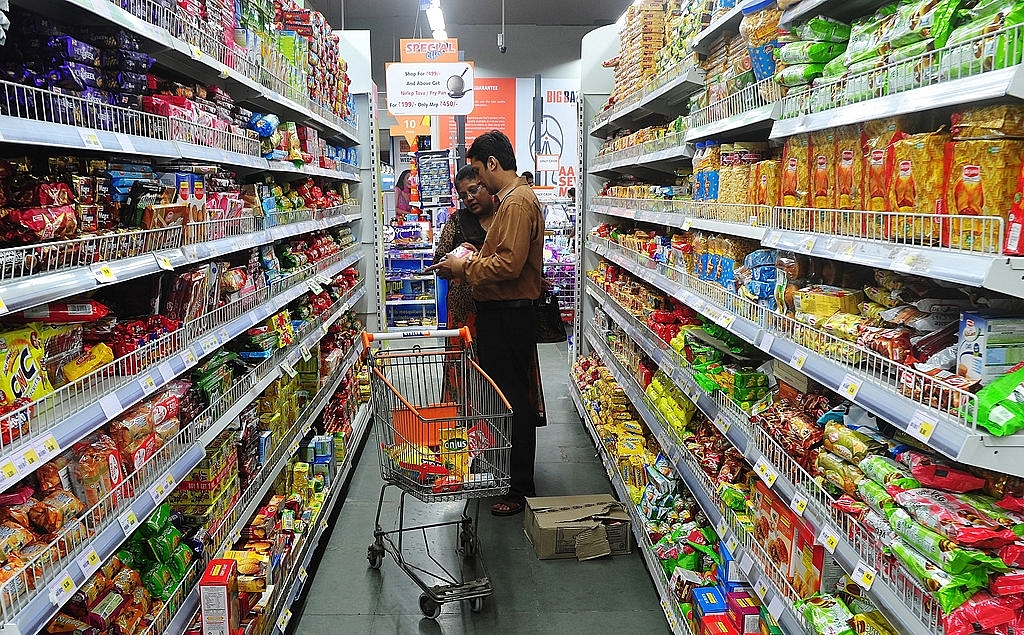Economy
Why India Has Got Its Policy Sequencing Just Right On Wal-Mart And Big Retail
- In keeping the Wal-Marts away from multi-brand retailing, India may actually have done them a favour since it was by no means certain that they could have done better than the Big Bazaars and Reliance Retails, which are yet to turn in a decent profit.
- India’s top domestic retailers are being pushed to the wall by online majors like Amazon and Flipkart, and Wal-Mart is unlikely to have done any better.

An Indian family shops at a supermarket in. Photo credit: INDRANIL MUKHERJEE/AFP/Getty Images
With hindsight, thanks more to
political logjam than policy intent, India appears to have got its multi-brand
retail strategy just about right, especially on the sequencing of reforms.
The argument against opening up multi-brand retail to the likes of Wal-Mart was protection of kirana stores, which provide employment to millions of Indians. While free market economists wanted to open up foreign direct investment (FDI) for ideological reasons, they were only half right. While it is true that India needs modern retail formats to expand consumer choices and to improve distribution efficiencies in the supply chain, it does not follow that allowing Wal-Mart to open retail stores is what needs to come first. It is not the Wal-Mart store that brings in distribution efficiencies, but the entire logistics chain at the behemoth’s backend - from sourcing to warehousing to cold storages and distribution.
The fact is the backend was always open for 100 percent FDI; it was only the front end that was - and remains - largely closed. This policy-by-default has ensured that the efficiencies generated from backend operations have benefited kirana stores as much as Wal-Mart, Metro and other wholesale distributors like Reliance. It also restrained big retail from cornering margins in every part of the supply chain.
In the US and North America, Wal-Mart destroyed small mom-and-pop stores; in India, the evidence is that Wal-Mart is empowering them, even though long-term trends will indeed reduce the ambit of kirana merchants, especially if online retailing hits the big time - as seems likely from current trends.
Here too we seem to have got things right in terms of policy sequencing. By restricting foreign direct investment to “marketplaces” rather than extending it to online retailing in general, small manufacturers and traders get a slice of the action and larger market access.
The Times of India today (18 August) reports that big retailers are, in fact, taking business away from India’s traditional wholesale distributors, stockists and super-stockists. The report says that wholesale chains like Wal-Mart, Metro and Reliance, with just 92 stores, have gained 2.6 percent of the total fast-moving consumer goods (FMCG) business from traditional wholesalers, and their cash-and-carry model is growing faster than traditional wholesale business, growing 13 percent against seven percent. The FMCG market is worth about Rs 2.6 lakh crore, according to Nielsen.
In keeping the Wal-Marts away from multi-brand retailing, India may actually have done them a favour since it was by no means certain that they could have done better than the Big Bazaars and Reliance Retails, which are yet to turn in a decent profit. In fact, India’s domestic big retail is being pushed to the wall by online retailers like Amazon and Flipkart, and Wal-Mart is unlikely to have done any better.
The reasons why big retail has found the going tough include the following:
India is not one market, but an
aggregation of regional markets with strong regional tastes. While there is a growing
national market for some brands, regional brands and tastes dominate. Big
retail, with its need to standardise and simplify, would have found it tough to
build scale in such fragmented markets.
The Wal-Mart format requires
huge retail space, something that is simply unaffordable in metro India, where
land prices are in the stratosphere. Making money on thin margins when real
estate costs are so high would have been tough even for a deep-pocketed company
like Wal-Mart. The formats that worked in the US, with its big out-of-town open
spaces, would have been tough to replicate in India.
The Indian market is still
evolving, and there are marked differences in the kind of stock-keeping-units
(number of sizes in which a brand is available) needed in metros and semi-urban
places, given huge differences in the income capacities of households. Re 2
shampoo sachets sell more than big bottles in many towns even now. Kiranas,
with their local knowledge, have a better understanding of these micro-markets
than a Wal-Mart. (For more on why Wal-Mart isn’t always successful in the emerging markets, read here)
By default rather than design,
India’s sequencing of FDI reforms has helped all players, from the humble
kirana showowner, to domestic big retailers, who got time to build scale before
the Bully of Bentonville could kill them with huge investments. Wal-Mart too
may not be unhappy to have been slowed down. Its learning curve did not have to
be financed by its own mistakes.
Introducing ElectionsHQ + 50 Ground Reports Project
The 2024 elections might seem easy to guess, but there are some important questions that shouldn't be missed.
Do freebies still sway voters? Do people prioritise infrastructure when voting? How will Punjab vote?
The answers to these questions provide great insights into where we, as a country, are headed in the years to come.
Swarajya is starting a project with an aim to do 50 solid ground stories and a smart commentary service on WhatsApp, a one-of-a-kind. We'd love your support during this election season.
Click below to contribute.
Latest